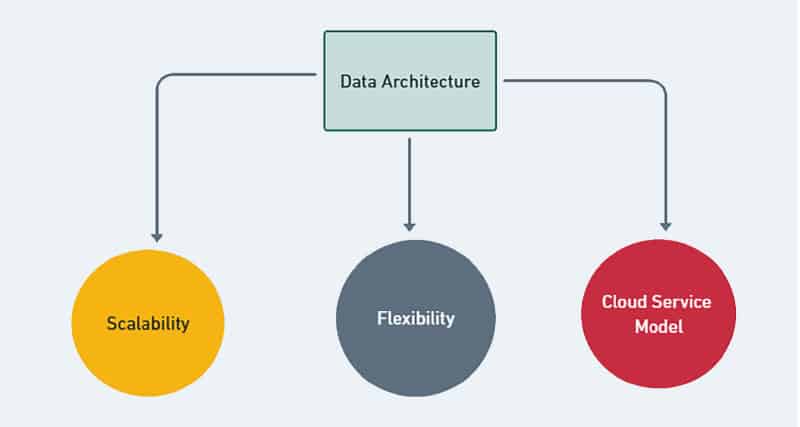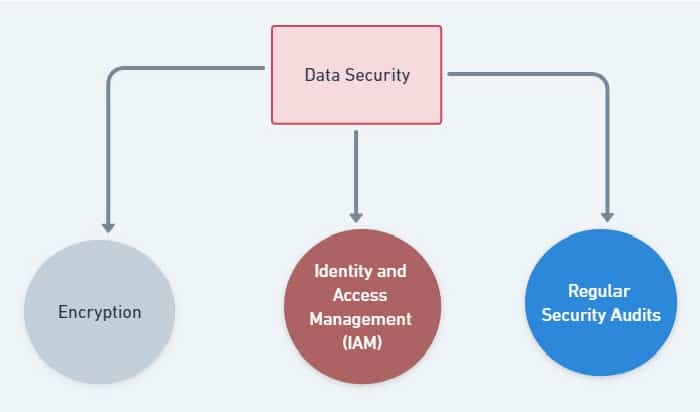Businesses are increasingly turning to cloud-based solutions for data management. A robust cloud data management strategy offers significant benefits like scalability, cost-efficiency, and enhanced security. Let’s explore the key components of an effective strategy and how businesses can leverage them for optimal results.
Cloud data management refers to the process of storing, managing, and protecting data that is hosted on a cloud platform. It involves various practices and technologies to ensure that data is securely stored, easily accessible, and effectively utilised by organisations.
Key components of a cloud data management strategy
The key components of a cloud data management strategy can be summarised as follows.

Data governance
Data governance establishes clear policies and procedures to ensure the accuracy, security, and compliance of your data.
- Data ownership: Clearly define who ‘owns’ the data and is responsible for its quality and usage (e.g., marketing team owns customer data).
- Data access controls: Set policies around who can access specific datasets and for what purposes.
- Data retention: Determine how long data needs to be retained based on legal and business requirements.
- Compliance: Ensure your data management practices adhere to relevant regulations like GDPR or HIPAA.
A comparison of different types of cloud data management storage
| Storage type | Description | Use cases | Examples |
| Object storage | Stores data as objects rather than files or blocks. | Storing large amounts of unstructured data like photos, videos, and backup files. | Amazon S3, Google Cloud Storage, Azure Blob Storage |
| File storage | Provides a traditional file-based interface. Suitable for shared file systems and NAS. | Applications requiring a file system interface, such as network attached storage (NAS) or file servers. | Amazon EFS, Google Cloud Filestore, Azure Files |
| Block storage | Stores data in volumes or blocks, each with its own address. Suitable for high-performance data. | Storing data requiring high performance and low latency, such as databases and virtual machine disks. | Amazon EBS, Google Cloud Persistent Disk, Azure Disk Storage |
| Database storage | Specifically designed for storing structured data in a DBMS. Optimised for fast and efficient access. | Applications requiring frequent access to structured data. | Amazon RDS, Google Cloud SQL, Azure SQL Database |
| Cold storage | Designed for storing infrequently accessed data for long periods. Cost-effective but with higher latency. | Storing data that needs to be retained but is rarely accessed, like archives. | Amazon Glacier, Google Cloud Storage Coldline, Azure Archive Storage |
| Hybrid storage | Combines on-premises storage with cloud storage for scalability and flexibility. | Organisations wanting cloud benefits while maintaining control over their data. | NetApp, Dell EMC |

Data architecture
A well-designed data architecture is the foundation for scalability and flexibility in the cloud. Here’s what to consider.
- Scalability: Choose an architecture that can easily scale up or down as your data volumes fluctuate.
- Flexibility: Design your architecture to accommodate new data sources and evolving business needs.
- Cloud service model: Select the appropriate cloud service model (IaaS, PaaS, SaaS) based on your desired level of control and infrastructure management.

Data integration
Seamless data integration across various cloud platforms and on-premises systems is crucial for a holistic view of your data. Explore tools like:
- AWS Glue: A serverless ETL service offered by Amazon Web Services that simplifies data extraction, transformation, and loading tasks on AWS.
- Azure Data Factory: A cloud-based ETL/ELT service from Microsoft Azure that allows data integration across various cloud and on-premises sources.
- Google Cloud Dataflow: A managed service for creating data pipelines on Google Cloud Platform. It supports a variety of data sources and processing options.
- Informatica Cloud Data Integration (ICDI): A cloud-native ETL/ELT platform offering pre-built connectors, data quality tools, and workflow automation capabilities.
Data security
Protecting your data is paramount. Implement robust security measures like:
- Encryption: Encrypt data at rest and in transit using cloud provider services like AWS KMS or Azure Key Vault.
- Identity and access management (IAM): Utilise IAM controls to restrict data access to authorised personnel only.
- Regular security audits: Conduct periodic security assessments to identify and address vulnerabilities.

Data backup and recovery
Data backup involves creating copies of data to protect against loss, stored separately for redundancy. Here are key considerations for data backup.
- Backup frequency: Determine how often you need to back up your data based on its criticality and how frequently it changes. Real-time backups might be necessary for highly sensitive data, while less critical data can be backed up daily or weekly.
- Backup location: Don’t store your backups in the same location as your primary data. Consider geographically dispersed cloud storage or on-premises backup solutions for added protection.
- Data encryption: Encrypt your backups at rest and in transit to safeguard sensitive information from unauthorised access, even in the event of a security breach.
- Backup testing: Regularly test your backups to ensure they are complete and readily recoverable. This provides peace of mind knowing you can restore your data promptly in case of an incident.
| Benefits | Description |
| Scalability and flexibility | Easily scale storage and processing capabilities according to business needs. |
| Cost efficiency | Eliminate the need for expensive on-premises hardware; pay for resources used. |
| Enhanced security | Advanced security features like encryption, access controls, and regular audits. |
| Improved collaboration | Access data from anywhere, at any time, and on any device, fostering collaboration among teams. |
| Disaster recovery and continuity | Robust backup and recovery mechanisms for quick data recovery and minimal downtime. |
Benefits of cloud data management
Data recovery is the process of restoring data from backups in case of loss or corruption. It ensures business continuity, data integrity, and compliance with regulations. Here’s what a robust data recovery plan entails:
- Backup cataloguing: Maintain a clear catalogue of your backups, including information like creation date, data source, and location. This ensures you can quickly identify the right backup for recovery.
- Point-in-time recovery: Some backup solutions allow you to recover data to a specific point in time. This is valuable when you need to restore data from a specific moment before an error or attack occurred.
- Disaster recovery plan: Develop a comprehensive disaster recovery plan that outlines procedures for responding to various data loss scenarios. This plan should define roles, responsibilities, and communication protocols to ensure a swift and coordinated recovery effort.

Implementing your cloud data management strategy
Step 1. Define your goals
- Align your cloud data management goals with your overall business objectives. What are you hoping to achieve with your data?
- Is it improved analytics, better data security, or cost optimisation?
- Having clear goals will guide your approach.
Step 2. Choose the right cloud provider
- Different cloud providers offer a variety of data management services (AWS, Azure, Google Cloud, etc).
- Research and evaluate which provider aligns best with your needs, security requirements, and budget.
- Consider a multi-cloud strategy if necessary.
Step 3. Develop data processes
- Standardise data ingestion, storage, integration, and access procedures.
- This ensures consistency, simplifies management, and improves data quality.
Step 4. Establish data governance
- Implement a data governance framework to define ownership, accountability, and access controls for your cloud data that mitigates security risks and ensures regulatory compliance.
Step 5. Train your team
- Equip your team with the skills and knowledge to manage data effectively in the cloud environment, which includes training on cloud data management tools and best practices.
By leveraging a well-crafted cloud data management strategy, organisations can unlock the true potential of their data to start their cloud-based data management journey and revolutionise the way data is managed.









































































